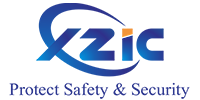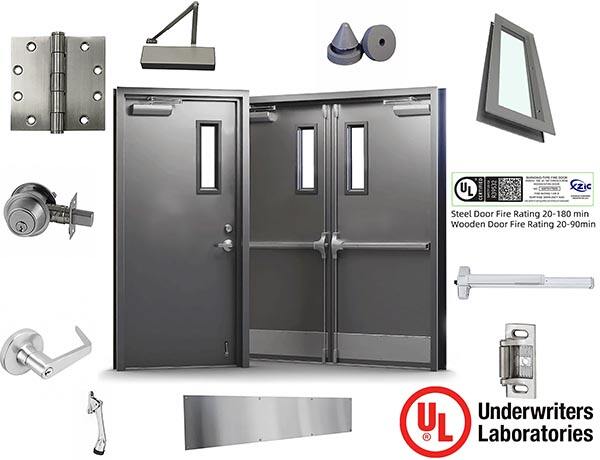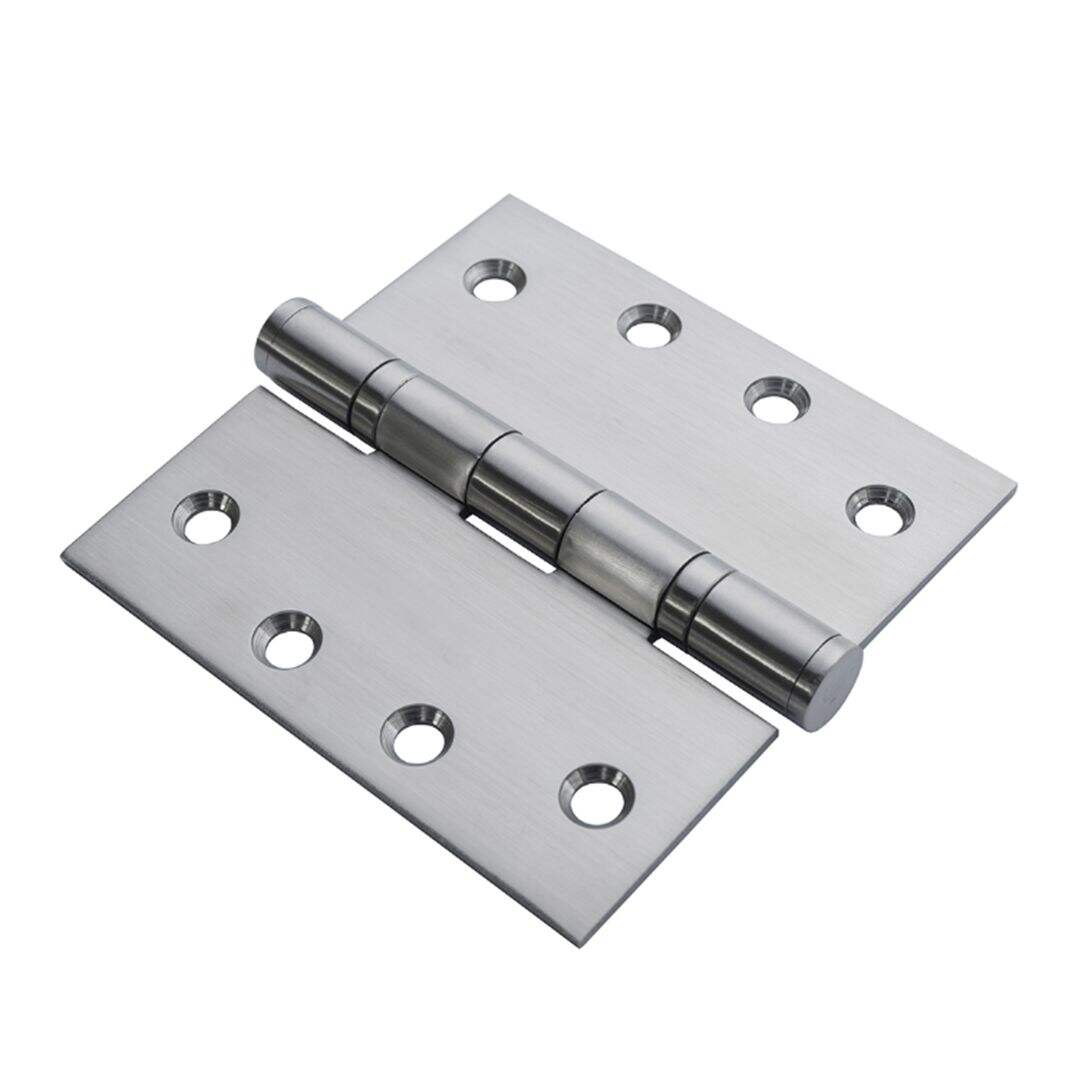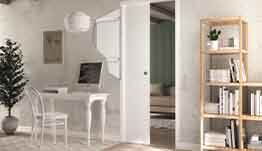অগ্নি রেটযুক্ত দরজার হার্ডওয়্যার নির্বাচন - লক সেট
অগ্নি প্রতিরোধী দরজার সেরা কাজের গুণমান এবং অগ্নি প্রতিরোধ ক্ষমতা নিশ্চিত করতে, দরজার সঙ্গে খাপ খাইয়ে উপযুক্ত হার্ডওয়্যার বাছাই করা খুবই গুরুত্বপূর্ণ। আশা করা যে অগ্নি প্রতিরোধ ক্ষমতা অর্জনের জন্য দরজা এবং এর হার্ডওয়্যার একসঙ্গে কাজ করতে হবে। আগের প্রবন্ধগুলিতে আমরা দরজা ক্লোজার এবং কব্জা নিয়ে আলোচনা করেছি। এই প্রবন্ধটি অগ্নি প্রতিরোধী দরজার জন্য উপযুক্ত তালা বাছাইয়ের পথ নির্দেশ করবে।
তালার ধরন
অগ্নি প্রতিরোধী দরজায় ব্যবহৃত সাধারণ তালাগুলি হল লিভার হ্যান্ডেল তালা , মর্টাইস লক , হ্যান্ডেল তালা , ডেড বোল্ট , এবং স্মার্ট তালা (হোটেল ধরনের) । এছাড়াও, প্যানিক ডিভাইসগুলি অগ্নি প্রতিরোধী দরজার জন্য সবচেয়ে সাধারণ তালা ধরনগুলির মধ্যে একটি। যদিও প্যানিক ডিভাইসের তালা লাগানোর ক্ষমতা থাকে, তবু দ্রুত অপসারণের সুবিধার্থে সাধারণত এগুলি খোলা রাখা হয়।
অগ্নি প্রতিরোধী দরজায় যখন হার্ডওয়্যার ব্যবহার করা হয়, তখন অবশ্যই অগ্নি প্রতিরোধী হতে হবে এবং প্রাসঙ্গিক অগ্নি নিরাপত্তা মানগুলির সঙ্গে খাপ খাইয়ে নিতে হবে। না হলে সম্পূর্ণ দরজা সংযোজনের অগ্নি প্রতিরোধ ক্ষমতা নিশ্চিত করা যাবে না।
মার্কিন যুক্তরাষ্ট্রের বাজারে, অগ্নি প্রতিরোধী দরজায় ইনস্টল করা তালাগুলি এমন মানগুলির সঙ্গে খাপ খাইয়ে নিতে হবে যেমন ইউএল 10সি , এনএফপিএ 80 , অথবা বিএস ইএন ১২২০৯ তাপমাত্রা সহ্য করতে পারে এবং আগুনের সময় কার্যকারিতা বজায় রাখতে হবে। লক এবং হ্যান্ডেলের উপকরণ অবশ্যই অগ্নি প্রতিরোধী হতে হবে (উদাহরণস্বরূপ, ষ্টেইনলেস স্টিল বা পিতল) বিকৃতি বা ব্যর্থতা প্রতিরোধের জন্য।
লিভার হ্যান্ডেল তালা
এ লিভার হ্যান্ডেল তালা একটি লিভার-স্টাইল হ্যান্ডেল দ্বারা পরিচালিত হয়, সাধারণত একটি স্প্রিং ল্যাচ বা ডেডবল্টের সাথে জোড়া দেওয়া হয়। এটি অভ্যন্তরীণ এবং বহিঃস্থ দরজাগুলোতে ব্যবহৃত হয়, সুবিধাজনক প্রবেশের সুযোগ প্রদান করে।
সুবিধা:
সহজ অপারেশন : লিভার ডিজাইনটি ঘূর্ণন নিয়ন্ত্রণের চেয়ে জরুরি অবস্থার জন্য আরও উপযুক্ত, বিশেষ করে বয়স্কদের, শিশুদের বা প্রতিবন্ধীদের জন্য।
এডিএ মেনে চলা : লিভার হ্যান্ডেলগুলি আমেরিকান ওয়ানথ ডিসঅ্যাবিলিটিজ অ্যাক্ট (এডিএ) এর প্রয়োজনীয়তা পূরণ করে, যা সব ব্যবহারকারীদের জন্য অ্যাক্সেসযোগ্য করে তোলে।
সৌন্দর্যময় এবং কার্যকর : বিভিন্ন ডিজাইন এবং ফিনিশগুলির সাথে উপলব্ধ যা ভিন্ন ভিন্ন সাজানোর শৈলীর সাথে মানানসই হয়।
অসুবিধা:
নিম্ন নিরাপত্তা : স্বাধীন লিভার হ্যান্ডেল লকগুলি (ডেডবল্ট ছাড়া) উচ্চ নিরাপত্তা সম্পন্ন বহিঃস্থ দরজার জন্য উপযুক্ত নাও হতে পারে, কারণ এগুলি সহজেই হাতুড়ি দিয়ে খুলে ফেলা যেতে পারে বা সরঞ্জামগুলি দিয়ে (উদাহরণস্বরূপ, ক্রেডিট কার্ড) এড়িয়ে যাওয়া যেতে পারে।
মর্টাইস লক
এ মর্টাইস লক এটি দরজার মধ্যে সংযুক্ত থাকে, লক বডি, ল্যাচ এবং/অথবা ডেডবল্ট অন্তর্ভুক্ত করে, সাধারণত লিভার বা নব দ্বারা পরিচালিত হয়। উচ্চ নিরাপত্তা এবং বহুমুখী দরজা সম্পন্ন পরিস্থিতিতে আগুন-প্রতিরোধী দরজাগুলিতে মর্টাইস লকগুলি সাধারণত ব্যবহৃত হয়।
সুবিধা:
উচ্চ সুরক্ষা : জটিল ডিজাইন, প্রায়শই পাঁচ-লিভার মেকানিজম সহ, খোলা বা জোর করে খোলা কঠিন করে তোলে, বীমা প্রয়োজনীয়তা পূরণ করে।
বহুমুখিতা : ল্যাচ এবং ডেডবল্ট ফাংশনগুলি সংমিশ্রণ করে একাধিক অপারেটিং মোড (উদাহরণ: পাসেজ, গোপনীয়তা বা লকড মোড) সমর্থন করে।
স্থায়িত্ব : দরজার মধ্যে সংযুক্ত হওয়ার ফলে মর্টাইস লকগুলি দৃঢ় এবং উচ্চ-ট্রাফিক এলাকার জন্য আদর্শ।
আগুনের পারফরম্যান্স : UL-প্রত্যয়িত মর্টাইস লকগুলি উচ্চ তাপমাত্রা সহ্য করতে সক্ষম, আগুনের দরজার অখণ্ডতা বজায় রাখে।
ডেড বোল্ট
এ ডেড বোল্ট একটি স্বাধীন তালা যাতে একটি বর্গাকার ধাতব বল্ট থাকে যা চাবি বা থাম্ব টার্ন দ্বারা পরিচালিত হয়, দরজা লক বা আনলক করতে পুরোপুরি বাড়ানো বা প্রত্যাহার করা প্রয়োজন। এটি সাধারণত সরলতর লকিং মেকানিজমগুলির পাশাপাশি একটি মাধ্যমিক তালা হিসাবে ব্যবহৃত হয়।
নিরাপত্তা নিশ্চিত করতে ডেড বোল্টগুলি দরজার কাঠামোতে অন্তত 1 ইঞ্চি পর্যন্ত ঢুকে থাকা উচিত। একক-সিলিন্ডার ডেড বোল্ট (বাইরের দিকে চাবি, ভিতরের দিকে আঙুল দিয়ে ঘোরানো) বাসযোগ্য ব্যবহারের জন্য উপযুক্ত, যা সহজেই বের হওয়ার সুবিধা দেয়। দ্বিগুণ-সিলিন্ডার ডেড বোল্ট (উভয় পার্শ্বে চাবির প্রয়োজন) উচ্চতর নিরাপত্তা সরবরাহ করে কিন্তু আগুনের সময় পলায়নকে বিলম্বিত করতে পারে, তাই এটি সতর্কতার সাথে ব্যবহার করা উচিত। ইনস্টল করার সময় প্রভাব প্রতিরোধ বাড়ানোর জন্য 3–4 ইঞ্চি স্ক্রু দিয়ে পুনর্বলিষ্ঠ স্ট্রাইক প্লেট নিরাপদ করা আবশ্যিক।
সুবিধা:
উচ্চ সুরক্ষা : The মৃত বোল্ট খুলতে প্রায় অসম্ভব, যা চুরি প্রতিরোধে শক্তিশালী নিরাপত্তা সরবরাহ করে।
সাদামাটা এবং টেকসই : এর সরল ডিজাইনের ফলে রক্ষণাবেক্ষণ খরচ কম এবং দীর্ঘমেয়াদী নির্ভরযোগ্যতা থাকে।
আগুনের পারফরম্যান্স : UL সার্টিফায়েড ডেড বোল্ট উচ্চ তাপমাত্রা সহ্য করতে পারে, আগুনের দরজার অখণ্ডতা রক্ষা করে।
নমনীয়তা : এটি একা বা হ্যান্ডেল লকের সাথে সংমিশ্রণে ব্যবহার করা যেতে পারে, বিভিন্ন পরিস্থিতির সাথে খাপ খাইয়ে নেওয়া যায়।
অসুবিধা:
অসুবিধাজনক অপারেশন : ডেড বোল্টগুলি ম্যানুয়াল লক/আনলক প্রয়োজন করে এবং স্প্রিং ল্যাচের মতো স্বয়ংক্রিয়ভাবে লক হয় না, যার ফলে মানুষ লক করা ভুলে যেতে পারে .
ডবল-সিলিন্ডার ঝুঁকি একটি অগ্নিকাণ্ডে, ভিতর থেকে আনলক করতে কী প্রয়োজন হওয়া সরিয়ে ফেলতে দেরি করতে পারে, এবং অগ্নিনির্বাপণ বিভাগগুলি সতর্ক ব্যবহারের পরামর্শ দেয়।
আমরা XZIC (শাংহাই জুঞ্ঝং ইন্ডাস্ট্রি কো। , লিমিটেড। ) আমরা আগুনের সহিত দরজা পণ্যের উপর বিশেষজ্ঞ। আমাদের কোম্পানি প্রতি বছর ৫০,০০০ সেট স্টিল ফায়ার দরজা এবং ২০,০০০ সেট ওড়া ফায়ার দরজা উৎপাদন করে। আমরা চীনে সবচেয়ে সম্পূর্ণ UL সার্টিফিকেশন রাখি। আমাদের উচ্চ-গুণবत্তার ফায়ার-রেটেড দরজা মূলত US এবং কানাডার মানকে অনুসরণ করে ডিজাইন করা হয়। এছাড়াও উচ্চ গুণবত্তার UL লিস্টেড হার্ডওয়্যার ব্যবহার করা হয়। স্টিল ফায়ার দরজা সর্বোচ্চ ৩ ঘন্টা ফায়ার রেটেড, ওড়া ফায়ার দরজা সর্বোচ্চ ৯০ মিনিট। আমরা আরও বাসা ব্যবহারের জন্য অন্য ধরনের দরজা তৈরি করি। সব দরজা কাস্টমাইজ করা যেতে পারে।
আরও তথ্য জানতে আমাদের ওয়েবসাইট দেখুন: www.ulfiredoormfg.com
আমাদের সেলস কনট্যাক্টের সাথে যোগাযোগ করুন ইমেল মাধ্যমে: [email protected]
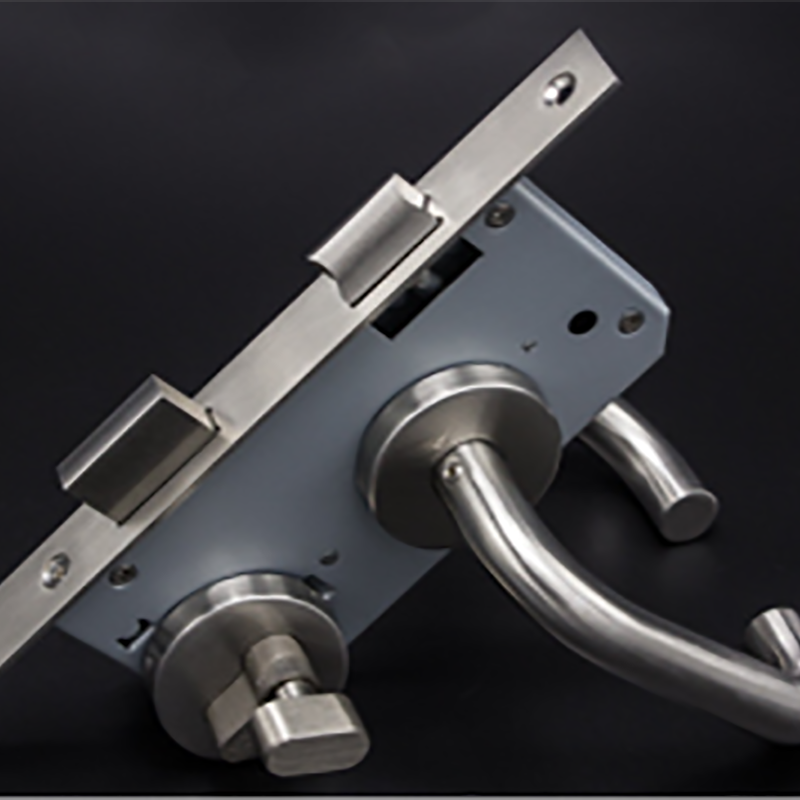
প্রস্তাবিত পণ্য
গরম খবর
-
UL অগ্নি দরজা নিয়ন্ত্রণ এবং প্রত্যয়ন প্রয়োজনীয়তা
2025-08-08
-
অগ্নি দরজার প্রকারগুলি কী কী?
2025-07-12
-
ব্যবসার জন্য কেন খোলা ধাতব দরজা একটি দীর্ঘমেয়াদি খরচ কার্যকর সমাধান
2025-07-23
-
মহোগনি/অ্যাক/বিচ/ওক ভেনিয়ার ফিনিশ এবং ফরমিকা/টিএকে/উইলসনার্ট ল্যামিনেটেড ফিনিশের তুলনায় UL LISTED FIRE DOOR এর দামের পার্থক্য কী?
2025-07-31
-
MDF (মিডিয়াম-ডেনসিটি ফাইবারবোর্ড) দরজা কী?
2025-06-15
-
UL মেটাল ফায়ার ডোর ইনস্পেকশনের গুরুত্বপূর্ণ দিকসমূহ
2024-01-02
-
কাতারে আমাদের মূল্যবান গ্রাহককে XZIC উচ্চ গুণবত্তার UL ফায়ার ডোর প্রদান করে
2024-01-02
-
খালি মেটাল ডোরকে ইনসুলেটেড করা যায় কি?
2024-01-02
 EN
EN
 AR
AR
 BG
BG
 NL
NL
 FR
FR
 DE
DE
 EL
EL
 IT
IT
 KO
KO
 PL
PL
 PT
PT
 RO
RO
 RU
RU
 ES
ES
 TL
TL
 IW
IW
 ID
ID
 UK
UK
 VI
VI
 TH
TH
 FA
FA
 AF
AF
 MS
MS
 SW
SW
 BE
BE
 UR
UR
 BN
BN
 KM
KM
 LO
LO
 LA
LA
 MI
MI
 MN
MN
 MY
MY
 KK
KK
 MG
MG
 SU
SU
 TG
TG
 UZ
UZ
 KY
KY
 XH
XH
